Sterling Starways: Silver Surfer #3 Review
This issue serves as a great introduction to a fiendish antagonist, placing the Surfer in a powerful tale of biblical proportions
—by Nathan on August 13, 2025—
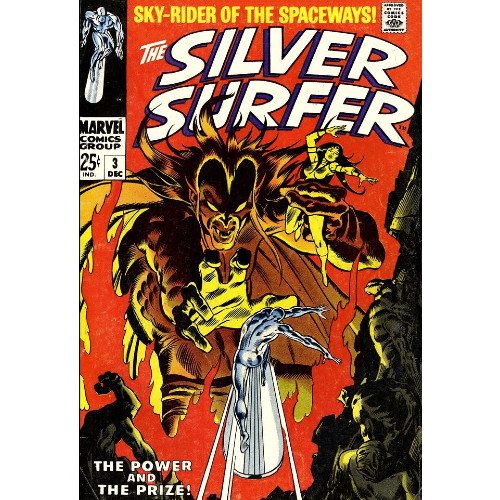
"From cradle to grave–your lives are rooted in senseless violence!"
So says the Silver Surfer after security guards with some pretty big guns attack the sentinel of the spaceways in a hospital. Why was the Surfer in a hospital? you ask. Merely checking in on the young girl he saved from the alien race called the Badoon at the end of the previous issue…shortly before the army showed up and, mistakenly believing the Surfer intended her harm, fired on him and drove him away.
You can probably see where the Surfer may become a bit agitated with such a pattern.
Three issues in, and the Surfer has made his stance on humanity clear: he finds us a confused bunch, swallowed up by greed and hatred, driven by our pride and all-consuming desire to destroy others…and, in doing so, destroying ourselves.
This former herald of Galactus has reached a point where he has had enough of us; yet in seeking to make an example of humanity, he has drawn unwanted attention from a crimson set of eyes, peering at him from the depths of his own Stygian dimension.
Mephisto, self-proclaimed Lord of Evil, has set his sights upon the Silver Surfer, seen in him an innate goodness humanity cannot reflect on its own, and begins to worry the Surfer will one day draw people away from the pollution of their selves, thus saving them from Mephisto's dimension of the damned.
The red-skinned "Lord of the Lower Depths," as he also calls himself, thus pulls the Silver Surfer into a tale of biblical proportions, with the audience dragged along with for the helling…I mean, "telling."
"The Power and the Prize"
Writer: Stan Lee
Penciler: John Buscema
Inker: Joe Sinnott
Colorist: Marie Severin
Letterer: Artie Simek
Issue: Silver Surfer #3
Issue Publication Date: December 1968
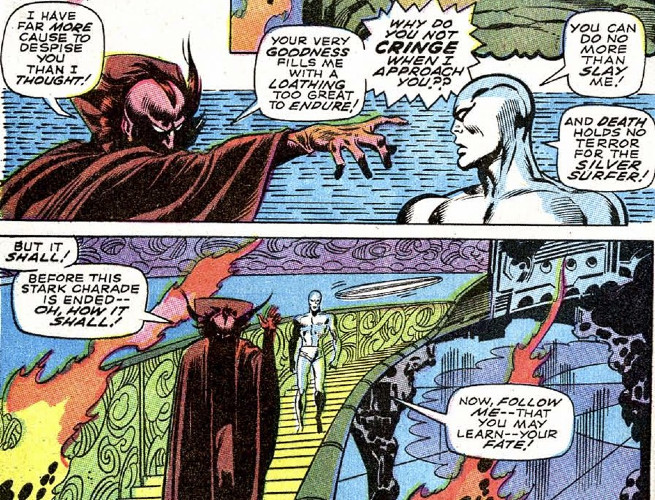
In the New Testament Gospels of Matthew and Luke, Jesus Christ is tempted three times by the devil, Satan. Satan tests Jesus through hunger and power, offering him food and authority over the kingdoms of the Earth, and also requesting Jesus show off his divinity. Each time, Jesus declines and rebukes him. It's a well-known narrative, and Lee seems to have been inspired by it in developing the crux of this narrative.
The connections aren't terribly difficult to make–Mephisto, for one, is very clearly a demon reminiscent of Satan, dwelling in a dimension reminiscent of Hell, though Lee never refers to it as such, which is probably wise in retrospect. Mephisto lacks the traditional horns and pitchfork, though Buscema's design gives him fangs, a sharp nose, pointy ears, and a hairdo which could be likened to horns–everything about him screams "evil," "danger," "stay away." Buscema develops a creature that is human in form yet inhuman in appearance and function, and if the physical details aren't evidence enough, Buscema also toys with the occasional lack of characteristics, shrouding Mephisto in shadow, with only his eyes peering out cruelly at all he surveys, making him feel like a cross between demon and vampire.
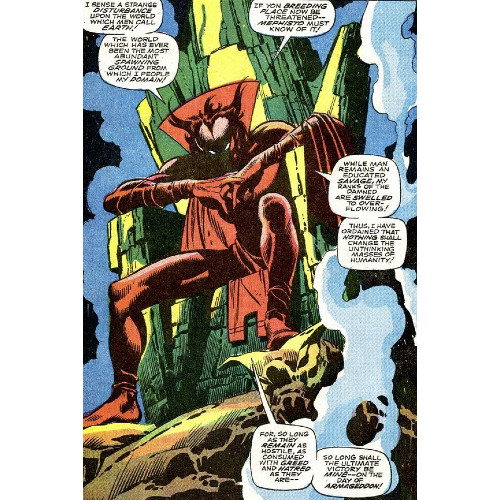
The tale woven around our principal players is an entertaining one, more so than the past two issues, and I will discuss it momentarily, but I really need to take a moment and consider the art. Buscema absolutely pours in a fantastic level of detail in this issue, delivering 40 pages (minus some full-page ads) of a snarling demon lord, the abysmal hellscape he dwells in, and our ever-worried Silver Surfer. There's a realistic quality reminiscent of Neal Adams in this issue, with Buscema etching emotion into very human faces, from soldiers to Silver Surfer's beloved Shalla-Bal.
The environments Buscema generates, particularly Mephisto's dimension, are just grotesque enough to bother the edges of imagination, with helpless souls intertwined and writhing in eternal torment. Buscema isn't looking to terrify or invoke nausea, but the sight of tormented figures trapped within stalactites or hapless hands grasping from a bubbling cauldron is enough to create the necessary chill and establish Mephisto's supremacy in his own kingdom. Whatever dimension Mephisto resides in–referred to, again, not as Hell, but as "a world beyond the farthest border of imagination–yet closer than the nearest nightmare!"–is fleshed out enough to feel substantial within the Marvel Universe, cursed with a dark purpose and history.
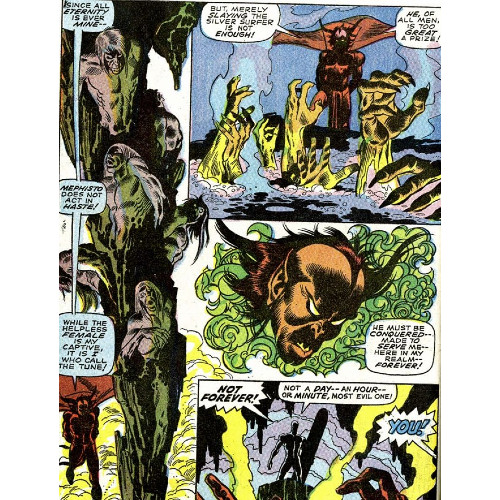
In Mephisto, Lee develops Marvel's version of Satan, and though later comics have established more supreme demonic entities, this "Lord of Evil" was the end-all, be-all of spiritual evil in 1968. His name a twisting of the demon popularized in the play Faust by Johann Wolfgang von Goethe, Mephisto represents the Silver Surfer's antithesis–where the Surfer sacrificed his freedom for the people of Earth and thus limited his ability to traverse the cosmos, Mephisto wheels and deals to claim the souls of others for the expansion of his own kingdom. His deep greed, his abounding lust for power, is contrasted with the Surfer's willingness to protect and defend humanity and, ultimately, his choice to make yet another sacrifice in order to defeat the "Lord of the Lower Depths."
Lee adds a wrench to the proceedings when Mephisto draws Shalla Bal into his twisted games, creating an additional layer of tension. Not only is Mephisto toying with the Surfer, but he's made a deal with the one person the Surfer loves more than life itself. The two aren't pitted against one another, and it may seem like Shalla Bal is just a pawn in Mephisto's game, but she actually becomes an important factor in the Surfer overcoming the devil's wretched games. Together, they turn Mephisto's plot upon himself, providing him only a Pyrrhic victory to savor while making a choice which breaks both their hearts. It's a powerful, painful moment to end the conflict, a difficult choice yet one which, I would argue, is constructed much more impactfully than when Mephisto would ask a certain Marvel superhero to surrender his greatest love as the price of a deal. The love between the Surfer and Shalla Bal becomes, not the cost Mephisto demands, but the counterbalance offsetting his schemes.

If Mephisto is intended to represent Satan, Lee takes his story into "morality play" territory by creating in the Surfer a character akin to Jesus Christ. Again, the biblical connections are somewhat obvious–like Christ, the Surfer is tempted by the devil, offered riches, love, and an entire galactic empire if he will only bow to the demon's desires. Lee's logic for the Surfer works well enough in this narrative, with the Surfer's reasoning for spurning Mephisto's persuasive techniques in line with his character. The Surfer doesn't quote Scripture, but he resists through a complete understanding of himself–a side that would not forsake Shalla Bal for other loves, a side that would not accept gleaming treasures after sailing the stars themselves. Note that, while Mephisto offers a galaxy for the Surfer to rule, he never mentions how he'd free the Surfer from his Earthbound prison, a fact the Surfer never questions either. If Mephisto could break those bonds, it's never mentioned, and though this could have just been an oversight on Lee's part, I struggle to believe that we are, at any point, supposed to trust the "Lord of Evil" (again, a name the dude calls himself!) would ever live up to his end of the bargain.
Scenes early in the issue don't necessarily test this "Surfer as Christ-figure" concept, but it does allow for a few wrinkles. Distressed by humanity's constant penchant for violence, against both himself and each other, the Surfer chooses to enact his rage on the planet. Stretching his arms out as if hung on a cross, the Surfer utters words I find similar to Christ's during the crucifixion: "Forgive me for what I am about to do! And grant me the strength so that I may forgive them who have driven me to do it!" It's very much an echo of Christ's "Forgive them, for they know not what they do" statement to his Father just before his death, but it's a twisted version, drenched in the Surfer's compounding frustrations with the people of Earth. While Christ genuinely asks God to forgive the ignorant people for hanging him from a cross, the Silver asks for forgiveness from some nebulous force prior to unleashing his rage, and the blame for him doing so lies with the people. His actions do not intentionally harm anyone, merely knocking out all power across the globe, and he eventually pulls back, but his intentions are clear: we cannot be trusted with the power we have taken for ourselves, and thus the Surfer strips away our abilities to harm each other.
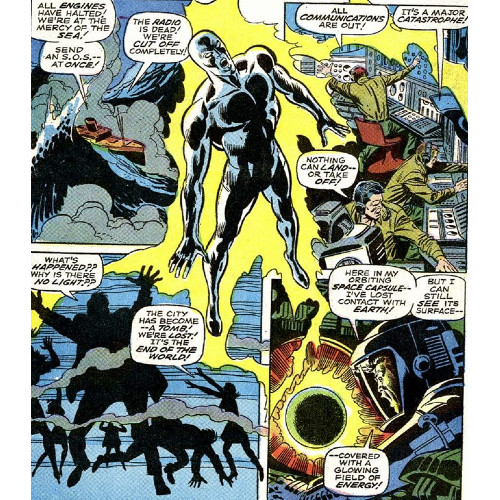
I would not argue Lee intends to be sacrilegious towards Christianity–nowhere does he make any cutting comments toward organized religion, Christ, or the Gospels. The Surfer's actions here, though paralleling Christ's in certain ways, point to the very emotions which would prevent him from an all-powerful savior. He is, in his own way, human. He burns with passion, reacts with rage, lets loose emotions which build and build over a period of time. He possesses dangerous qualities which, if left unchecked, could make him as much a villain as he is a hero. After warping the Earth to his designs, the Surfer sees the irony in his behavior–how he has used violence to counteract violence–and undoes his actions. He's not perfect, just noble enough to bother Mephisto, who I assume wouldn't give one thought to the consequences of using his power to bend the world to his will.
As in the other Silver Surfer issues, Lee, along with Gene Colan, presents a "Tales of the Watcher" back-up, and this one is more amusing than last issue's. I complained that the tale told in Silver Surfer #2 touted itself as a sci-fi classic recreated from an original Lee/Steve Ditko story yet failed to live up to expectations. This narrative makes no boastful claims, presenting the tale of a man seeking help after encountering an alien spaceship. Lee and Colan create decent tension and end on a satisfying "duh-duh-duh!" note; a twist, depending on your take, could either be surprising or fairly obvious–a line of dialogue presents the possibility, yet another narrative beat may cause the discerning reader to consider alternative angles. I still wouldn't call this a classic–neither this nor the prior story contain the parable qualities of the first issue–but it's a better attempt at sci-fi drama.
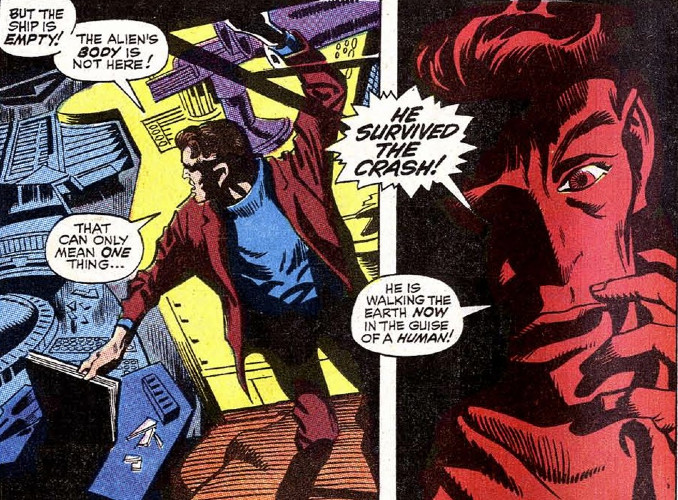
It feels a little strange calling a story that introduces the Marvel Universe's version of Satan "good," but this is a strong issue. Maybe I should call it "bad," like in a punk teenager kind of way. The story is bad, the visuals are sick…in all seriousness, Lee and Buscema nail the right notes in this one, creating a biblically influenced story of temptation and resistance, with a seemingly shimmering savior who needs saving. That vulnerability, that humanity, removes those salvific qualities and makes him just a "hero," but the Surfer is the kind of hero we want to see rescued, facing the kind of villain we absolutely want to watch lose.